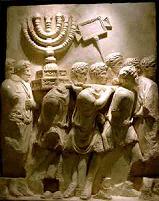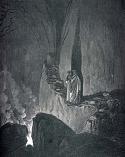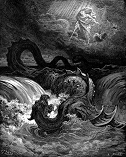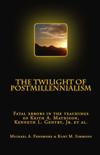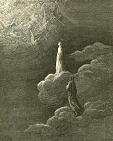A SUBSTITUTE FOR HOLINESS
OR
ANTINOMIANISM REVIVED
OR
ANTINOMIANISM REVIVED
THE THEOLOGY OF THE SO-CALLED PLYMOUTH BRETHREN EXAMINED AND REFUTED.
BY
DANIEL STEELE, S.T.D.

CHAPTER XIV DIFFICULTIES IN THE THOUSAND YEARS
[Editor's note: Steele wrote against Premillennialism as taught by the Plymouth Brethren. We include chapter fourteen of his work here because of his comments that there are two millennia in Revelation twenty (No. 5, below). Steele's book may be visited on-line at http://www.gospeltruth.net/Antinomianism/antinom_toc.htm].
We object to the millenarian scheme, because it is grounded chiefly on those portions of the Bible which are symbolic, and enigmatic, and difficult to be understood. The personal reign of Christ a thousand years is not found in the Gospels, nor in the Acts of the Apostles, nor in the Epistles of Paul, Peter, James or John, but only in the Apocalypse, which is the darkest book in the New Testament. Its striking symbols and gorgeous imagery impress the imagination and awaken the feelings. The visitor in London will find in one library a thousand commentaries on this book, all professing to unfold its mysteries, all differing, so that only one of them can be true. These writers have tried to interpret the apocalyptic numbers, and they have signally failed. From Bengel's date of the binding of Satan in 1836 down to the present time, the years fixed for the coming of Christ have passed away, and the expositors who have survived their disappointment have courageously tried again, by shifting their ground into the safer future. There are three great schools of interpreters of the Revelation: (1) The Preterists, or those who teach that the whole, or by far the greater part, has been fulfilled. Some of the most eminent German expositors, as Ewald, De Wette, Lucke, and Dusterdieck, belong to this school; also Dr. Davidson in England, and Moses Stuart in America. (2) The Historicals, who hold that the Revelation embraces the whole history of the Church to the end of the world. (3) The Futurists, who insist that this book, after the third chapter, relates entirely to future events. Some include the first three chapters, and assert that they refer to the future also.
This is the grand outline of opinions held by men equally learned and honest; yet on a book whose interpretation is in so great dispute, the doctrine of a thousand years' personal reign of Christ on the earth before the last judgment is grounded by those who would interpret the plain and the literal teachings respecting the last things by the symbolic and typical, thus inverting an acknowledged canon of interpretation. The twentieth chapter of the Revelation is the basis of pre-millenarianism. Let us now examine this chapter, and see what is not proved by its testimony.
1. There is no mention of the second advent of Christ before the thousand years. The chapter opens with the vision of an angel descending from heaven with a chain in his hand. This angel can never be proved to be Christ. Says Alford: "Angelos, in this book, is an angel; never our Lord." Thus far in the Apocalypse there is not the slightest intimation that He has made His second advent in visible term. In chapter xix. 11-21, He wars against the beast, and the kings of the earth and their armies; but the assumption that this is a literal battle fought on the earth by Jesus in person, riding on a white horse, with a sharp sword going out of His mouth, is a literalism which cannot be endured, besides being a begging of the very question in dispute. John saw the things in the opened heaven, and he saw "the armies which were in heaven." The Scriptures are unanimous in making heaven the fixed abode of Christ, until He shall come to judge mankind at the last day.
2. John saw only the souls of the martyrs. He makes no mention of their bodies. There is a grave doubt whether a bodily resurrection is here intended; but we are inclined to the literal resurrection of these martyrs. In John v. 25, we have a resurrection of souls, followed in verse 28 by a bodily resurrection. This, in the opinion of many, explains the first and the second resurrections in this chapter. The passage is obscure, admitting of different interpretations.
3. There is here no proof of the resurrection of all the righteous dead, but only of the beheaded martyrs; so that allowing the literal resurrection of these does not prove that all the saints rise at this time. Every man is to rise in his own order. Some arose at the Resurrection of Christ, and doubtless were His convoy to heaven. It may be that a special honor and blessedness await the beheaded martyrs in the fact of their resurrection and translation to heaven before the rest of the dead saints: "for one star differeth from another star in glory." This does not preclude these from standing with Enoch and Elijah, in holy boldness, before the judgment seat of Christ in the last day. This may explain Paul's aim at a martyr's death and the resurrection of the beheaded (Phil. iii. 10, 11). "On such the second death hath no power." The dying of these martyrs, in a manner so heroic, utterly vanquished the mighty enemy. An early restoration from the dominion of death, suffered prematurely for Christ, is an eminently appropriate reward: "Holy and blessed is he that hath part in the first resurrection."
4. There is in this chapter a total absence of proof that these raised martyrs reigned with Christ on the earth. The visions thus far have been located in heaven. Consistency with the whole context requires that they should reign with Christ in heaven, and not that Christ should reign with them on earth. Bengel, Wesley, Moses Stuart, and many others, say, "in heaven and not on the earth."
5. There is no evidence here that a single millennium is spoken of. The best scholars, and among them Bengel, Wesley, and Dr. Owen, assert that there are two distinct periods of a thousand years spoken of in verses 1-7. The Greek article sustains this view. The first period extends through the repression of Satan which, Bengel says, indicates the great prosperity of the Church. The second is the reign of martyrs. Both of these periods are before the second coming of Christ. Thus Bengel and Wesley, instead of being Pre-millenarians, were, in fact, what most modern Methodists are, post-millenarians. Bengel styles those who confound these two distinct millennial periods, "pseudo-Chiliasts." The Prophetic Conference thus falls under Bengel's censure as pseudos. He says: "Whilst Satan is loosed from his imprisonment of a thousand years, the martyrs live and reign, not on the earth, but with Christ; then the coming of Christ in glory at length takes place at the last day; then, next, there is the new heaven, the new earth, and the new Jerusalem." Thus the coming of Christ is two thousand years plus a little season after the binding of Satan. A harmless sort of Chiliasm is this. Says Bengel: "The confounding of the two millennial periods has long ago produced many errors, and has made the name of Chiliasm hateful and suspected."
6. It is a very important point for the millenarian to prove, that the judgment of the dead before the great white Throne is that of the wicked dead only. But this vital point is not proven by this chapter. In fact, the bringing forth of the Book of Life and the casting into the lake of fire of those whose names aren't written therein, imply that some were found inscribed. Dr. Brooks' declaration that this Book of Life is a blank book, is a baseless assumption. This is not proved by the words, the rest of the dead lived not," etc. Says so eminent a Greek scholar as Dr. Owen: "Yet as the words here stand, we cannot, without, great violence, make 'the rest' (in Greek) embrace any other than the class of the pious dead, from which the martyr saints have been previously taken to participate in the first resurrection." We quote Dr. Owen, not to endorse him, but to show the difficulty of proving that this is a judgment of the wicked dead alone.
We believe that it is the general judgment of the race described in Matt. xxv. 31-46, and that "the rest of the dead" include all the human dead, both righteous and wicked, except the martyr saints, and that the good and the bad will be raised in the general resurrection and sentenced in the general judgment.
7. We look in vain, in this account of the millennium, or millenniums, for any reference to the Jews as being gathered to Jerusalem. The Revelation strangely omits to associate them with either of these chiliads. In chapter seven, the angels seal exactly twelve thousand of each of the twelve tribes, but there is no hint of the restoration of the Hebrew nation to their own land. After the day of general doom, the last great day, there descends a new Jerusalem into the new earth which has no more sea. Even then "the tabernacle of God is with men," not with the Jews.
Considering the fact that the old Testament prophecies are constantly quoted by the millenarians in proof of the personal reign of Christ on earth, with the Jews as His most loyal supporters, it is to us an insuperable objection to the doctrine, that the book of Revelation omits to place the restored Hebrew nation in any such relation to Christ, either in the old or the new Jerusalem.
If there is to be a personal reign of Christ on the earth, during a thousand years, to subdue the nations, as a substitute for the conquest now being made by the Holy Spirit, it is remarkable that these seven essential facts should be absent from the only account in the whole Bible where the millennial period is spoken of.
These important items are culled from dark prophecies, often violently wrenched from the context, and are fitted together on the pedestal of this chapter of a book which has been an inexplicable enigma to the scholarship of all the Christian ages. This style of interpretation may be satisfactory and convincing to those who accept imagery for doctrine, symbol for substance, and rhetoric for logic; but there are Christian minds which have an unconquerable aversion to stitching together selections from the symbolry of the prophets, literalizing the whole patchwork, and holding it up to the world as God's truth. Yet this is what the pre-millenarians are perpetually doing. They opened their recent Conference with the disclaimer that they had not brought their ascension robes with them. But such is the perilous fascination of their method of prophetic studies, that they will soon be attracted to an interpretation of the apocalyptic numbers and a determination of the year and day when, in the language of Mr. Barbour, "Christ is due," as we say of an express train. History always repeats itself. This has been the outcome of every great millenarian movement. The leaders may keep their own intellectual balance quite well, but by deluging Christendom with their literature, they will soon shake the minds of Christians of less steadiness who will insist on bringing to the next Prophetic Conference their arithmetical charts of Daniel's animals, if not their ascension robes. We who survived 1843 know the sequel.
To receive Kurt Simmons’ e-mail newsletter, The Sword & The Plow, click the Subscribe link:
All rights reserved.
